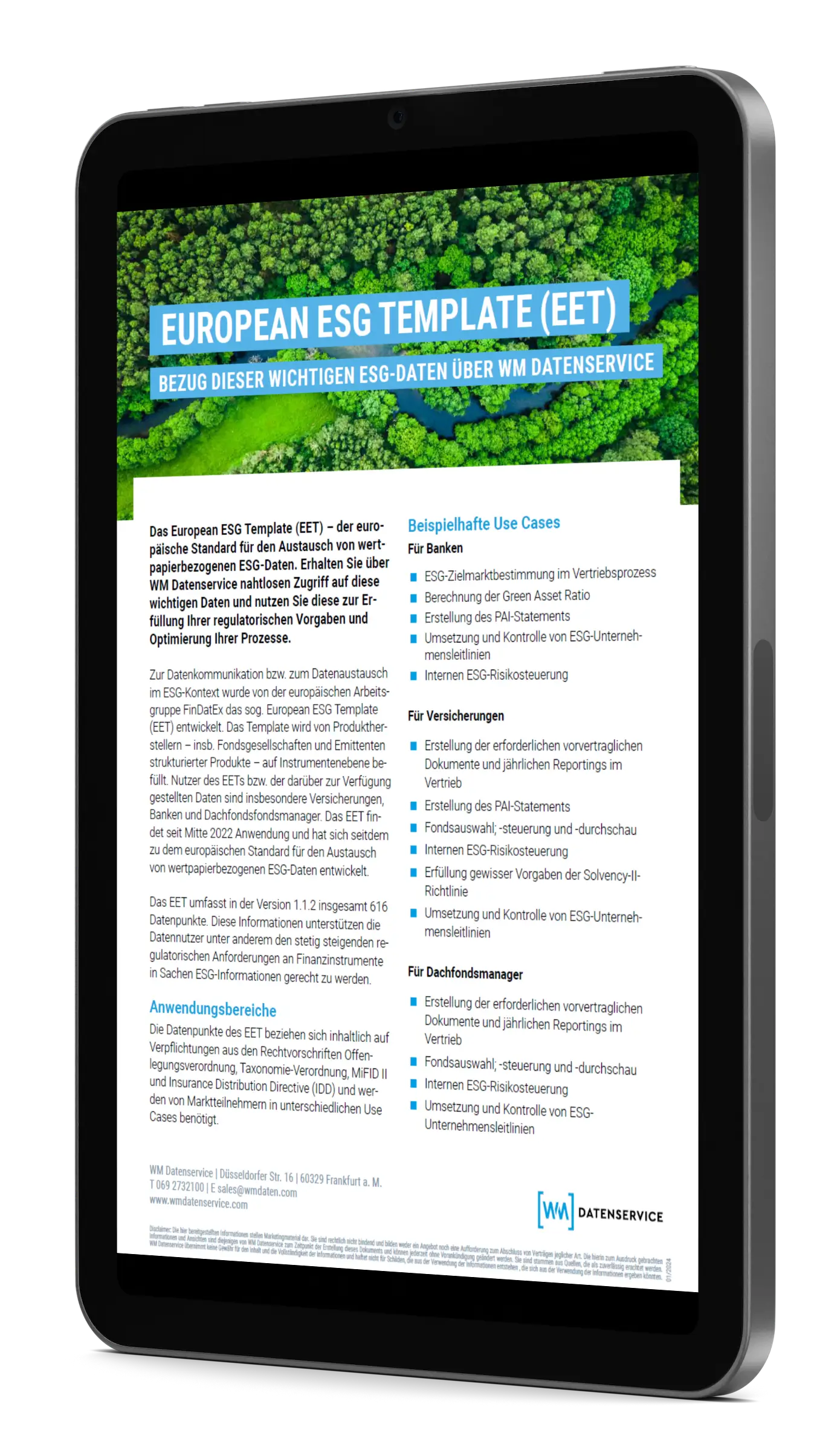European ESG Template (EET)

European ESG Template, the European standard for the exchange of ESG data on financial instruments
The European ESG Template was first publicised in March 2022 and has quickly established itself as the market standard for the exchange of securities-related ESG data. The content of the EET data points is based on the requirements of the Sustainable Finance Disclosure Regulation (SFDR), Taxonomy Regulation, MiFID II, and Insurance Distribution Directive (IDD).
The EET was developed by FinDatEx, an association of leading European organisations from the financial sector (including the European Banking Association and EFAMA). The aim of this organisation is to develop standardised templates that are used by the European financial market for (regulatory required) data exchange. The European MiFID Template (EMT) and the European PRIIPs Template (EPT) are already well established FinDatEx templates.
The EET in practice
Product manufacturers, in particular fund companies and issuers of structured products, fill in the EET per ISIN at instrument level. The template was designed for these asset classes in particular. In practice, however, EETs are also used for other asset classes such as bonds or warrants. As a data hub, WM Datenservice receives this data from issuers, processes it, and makes it available to market participants such as insurance companies and distributors.
The exchange of data between market participants such as fund companies, issuers of structured products on the one hand and distributors of financial investment products, insurance companies and funds of funds on the other is greatly simplified via the EET: Sustainability-related information on financial instruments is recorded in a standardised form, evaluated in a machine-readable format, and transported in a structured form.
Use Cases for EET data
Depending on the segment of activity in the financial market, there are different areas of application for the data points that are transported via the EET:
• determine ESG target markets in the sales process
• calculate the green asset ratio
• prepare the PAI statement
• implement and monitor ESG corporate guidelines
• to manage internal ESG risks
• prepare the pre-contractual documents and periodic reports required in sales
• prepare the PAI statement
• select, manage and review funds
• manage internal ESG risks
• fulfil certain requirements of the Solvency II Directive
• implement and monitor ESG company guidelines
• prepare the pre-contractual documents and periodic reports required in sales
• select, manage and review funds
• manage internal ESG risks
• implement and monitor ESG company guidelines
Receiving the EET via WM Datenservice
WM Datenservice offers the 616 EET data points in four different products: One product maps all EET data points and three „sub-products“ provide content-related EET data points. The three sub-products each serve specific use cases and enable reduced data collection in predefined data sections:
- EET-Complete: Contains all data points of the European ESG Template
- EET-Screening: Contains all data points of the EET on exclusion criteria & EET-specific master data
- EET-PAI: Contains all data points of the EET on the Principle Adverse Impact Indicators & EET-specific master data
- EET-Financial Instrument Data: Contains selected data points of the EET on sustainability-related data of the financial instrument & EET-specific master data
Each data point of the EET is mapped 1:1 in the product solutions of WM Datenservice. Customers therefore always receive an exact representation of the applicable version of the EET with the WM products.
Your advantages
In short – our factsheet on the European ESG Template
The FinDatEx working group developed the European ESG Template (EET) to enable the exchange of securities-related ESG data in a structured and standardised manner. You can find more information on how to obtain this regulatory relevant ESG data via WM Datenservice in our factsheet.
Contact
Please don’t hesitate to contact us if you have any further questions about our product European ESG Template?
Simply send us a message! We will take care of your request as quickly as possible.
We are available by telephone on working days (Mon-Fri)
between 9.00 and 17.00 hours.
Phone: +49 (0) 69 2732 – 100
Mail: sales(at)wmdaten.com
FAQs EET
What is the European ESG Template (EET)?
The European ESG Template (EET) is a standardised template intended to facilitate the exchange of ESG data for financial products between manufacturers and stakeholders. The aim is to meet the ESG-related regulatory requirements contained in the Disclosure Regulation (SFDR), Taxonomy Regulation, MiFID II and Insurance Distribution Directive (IDD).
An update of the EET is typically done on an event-driven basis, usually at the end of a financial product’s fiscal year.
What did change with the EET version 1.1.2?
On 20 December 2023, FinDaTex published the latest version 1.1.2 of the European ESG Template (EET) with 616 data fields. In the new version, two new fields have been created and the filling guidelines for some existing fields have been changed. We have summarised the exact changes to the previous version for you in our ESG short „European ESG Template (EET) Version1.1.2“ ESG Short
Who developed the EET and why?
The European ESG Template (EET) was first published in March 2022 and has quickly established itself as the industry standard for the exchange of ESG data related to securities. The EET data points are compliant with the Disclosure Regulation (SFDR), the Taxonomy Regulation, MiFID II and the Insurance Distribution Directive (IDD).
The EET was developed by FinDatEx an association of leading European financial organisations, including the Euro Banking Association (EBA) and the European Fund and Asset Management Association (EFAMA). Its aim is to develop standardised templates that can be used in the European financial market for the (regulatory necessary) exchange of data.
What is the Sustainable Finance Disclosure Regulation (SFDR)?
The Sustainable Finance Disclosure Regulation (SFDR) came into force in March 2021, followed by an extended version (Level 2) on January 1, 2023.The Level 2 regulation stipulates, among other things, that companies must submit a PAI statement in which the most important negative impacts on the climate and environment are disclosed.
The main purpose of the regulation is to create transparency for investors on sustainability aspects in the financial sector. Specifically, the regulation requires financial market participants and financial advisors to disclose information on the integration of sustainability risks in their investment decisions. This is to be ensured by so-called pre-contractual and regular documents. The Disclosure Regulation imposes complex disclosure obligations on product manufacturers (including asset managers and insurance companies) at company and product level.
The SFDR specifies three different product categories:
- Products in accordance Article 6 SFDR: These products take sustainability risks into account in their investment strategy. They do not primarily aim to invest in companies that have a clearly recognisable positive impact on environmental and social objectives.
- Products in accordance with Article 8 SFDR: These products integrate ESG criteria into their investment strategy and additionally incorporate environmental and/or social characteristics into their process in a mandatory manner. These can be, for example, economic activities that contribute to the achievement of environmental goals based on certain indicators.
- Products in accordance with Article 9 SFDR: : These products pursue a sustainable investment objective and take binding account of environmental and/or social characteristics.
Abbreviations
Make an appointment







